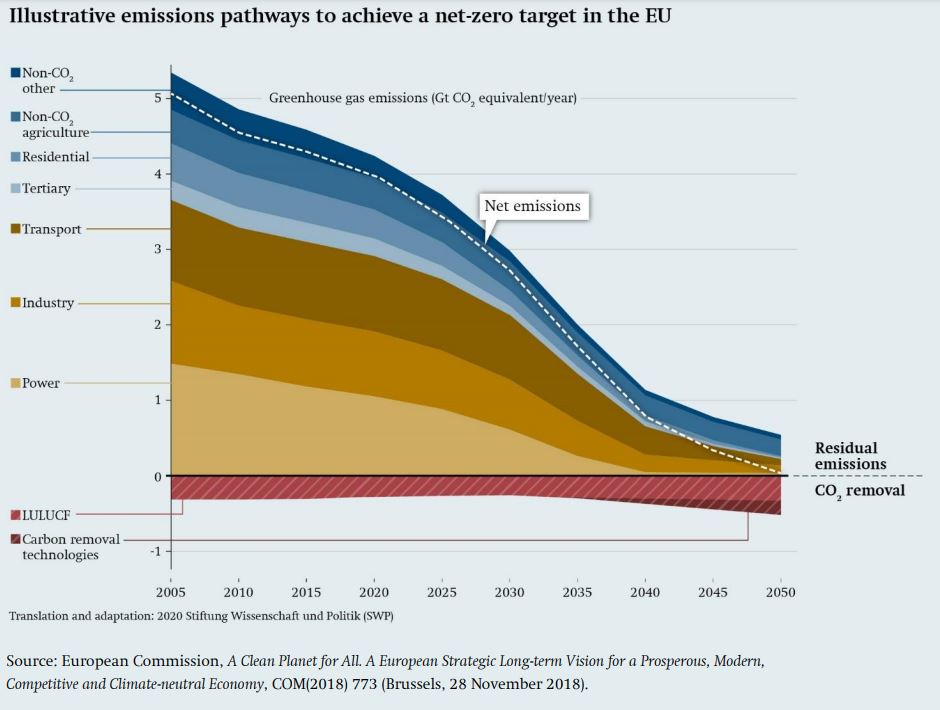As humans, far too often we think about what do today instead of planning what our future should be like. The result is a limited solution space.
Algae have incredible possibilities to change our world and climate for the better. Let’s think about using algae – on a large scale.
Key messages you will read in this post
- Algae can bind so much CO2 from the atmosphere that the climate targets of the EU-27 can be achieved [without algae it will be tough]
- Algae farming can provide the calorie needs of entire continents
- We need to start pushing algae as a solution on a large scale now
“If you have visions, you should see a doctor,” what a wonderful quote from a well-known politician. Yet Helmut Schmidt himself had precise ideas of an orderly world. At the moment, we as a German, European, Western and even global society are intensively concerned with the question of how we can live sustainably. Climate neutrality is the vision of our time. Plans for this have been agreed, whether they will be met is questionable. They will dependent on the speed with which we reduce CO2 emissions.
An extremely exciting question of climate neutrality is the compensation of the residual CO2. That is, the “capture” of CO2 equivalents from the atmosphere that we cannot avoid. This is likely to include parts of agriculture, heavy transport such as ships, trucks, planes, and industry such as cement and aluminum production, which emit carbon in the process even without heating by fossil energy.
We have to become CO2-neutral, i.e. Net-Zero, because otherwise it will get hotter and hotter. It is not enough to get to a level of, say, only 10% of current CO2 emissions. Because even this small amount compared to today would cause the temperature to rise more and more. So net zero is not an option, net zero is a must.

The picture shows how extremely successful we will have to be in the next few years to become CO2-neutral by 2050. The dark red “Carbon Removal Technologies” in the diagram are to actively remove CO2 from the atmosphere, these will be activated from 2035 onwards, i.e. very late. We are convinced that algae are an additional natural technology to capture CO2 on a significant scale even earlier, ready to start now.

In 2019, the EU-27 consumed a total of 3.6 gigatons (Gt) of CO2. Germany alone had emissions of 809 million tons of CO2. Even small countries like the Netherlands had emissions of 180 million tons. If we now assume that we can save about 75% of this emission through green technologies like solar, wind, thermal insulation (the EU is planning an even higher reduction of about 90%), that still leaves about 1 Gt of CO2 that our 27 countries emit into the atmosphere per year. That’s kind of unsatisfying and a bit depressing. But don’t worry, the solution through algae is in reach.
Algae are awesome
Algae create biomass faster than any other living thing, doubling in size every few days. They are edible and contain calories, often over 3,000 kcal per kg. And they are healthy too.
If Germans tried to recapture our emitted CO2 from the atmosphere using algae technology, Germany would need about 22,500 sq.km to do so. That would correspond to about 20% of the area we currently use for arable farming. Of course, we would not use this area in Germany – because, first, our land is already being put to good use and, second, algae (fortunately) do not grow very well on German farm-land. Afterall, we would like to avoid the climatic conditions necessary to grow algae in Germany. So we would have to go to the oceans or work with open basins in warm, unused regions outside Europe, e.g. in the Sahara desert. Cooperation with the global south is necessary, would create jobs there and could mitigate – or even solve – our CO2 problem.
Okay, that sounds ambitious. Should we therefore dismiss the idea out of hand? Absolutely not, because every hectare of algae cultivation helps us achieve the Net Zero scenario in the first place. However, the reality gap is huge. The largest European algae productions currently have a cultivation area of about 16 hectares, or 0.16 square kilometers. That is vanishingly small compared to what is needed.
The European Commission’s Net Zero diagram (above) could therefore be more ambitious if algae cultivation played a significant role. By offsetting CO2 through algae, we could reach the net-zero point earlier and would also have the potential to turn back climate change. If algae bind more CO2 than we additionally emit (net-negative scenario), the CO2 concentration in the atmosphere will reduce and it may even become cooler again.

Wouldn’t it be great if we made algae part of our climate strategy so quickly that we reach Net-Zero as early as 2040? Maybe other continents looking at algae as a solution and will get on board, too? It’s a nice thought.
The question remains: What should we do with 1,000 million tons of algae per year. It’s quite a lot of green sauce. The best approaches are those that permanently bind carbon and thus reduce the concentration of CO2 in the atmosphere permanently, e.g. turn algae into building materials, bioplastics for the production of windows, doors, chairs, machines.
The second best idea is to avoid additional emissions, i.e. to substitute fossil fuels. In this case, algae-bound carbon from the atmosphere is turned into fat by the algae, then converted into bio-fuels such as diesel or kerosene, and then untimately burned again. The net effect is zero, i.e. CO2-neutral. This is because the extracted (bound) CO2 is simply emitted again. But at least a further enrichment of the atmosphere with CO2 can be prevented. It would allow us to operate ships, airplanes, trucks in a CO2-neutral way. Pretty cool, indeed!
Alternatively, we eat algae. Let’s ignore the fact that mammels metabolize CO2. Either our life stock including fish or us as humans could eat the algae. An example: Statistically an adult takes up approx. 3,500 kcal per day. A healthy diet would be 2,500 kcal. If we produce different substances from different algae, e.g. omega-3 oil from Nannochloropsis or proteins from Chlorella and algae salad from Ulva etc. with an average energy density of 3 kcal per 1g algae, then the EU with an annual demand of 400,000 billion kcal would have an algae demand of only 135 million tons; that means only one seventh of a gigaton.
Compared to the CO2 challenge, feeding the world through algae appears almost simple.
We will collect algae recipes and publish them in a separate blog post.
Algen are a solution
Granted, that was really big thinking. But why not? If we as a society, each of us individually or all of us together, wanted to take this approach, we could.
Do we dare to do it?
Side note: The figures mentioned in the blog are researched to the best of our knowledge and belief, but the accuracy can not be guaranteed. We can discuss further questions about costs and financial feasibility separately. Let me say this: If we all wanted algae as a solution, it would be financially feasible. After all, algae do not only cost money, they are also deliver a lot of value!
If you now have an algae vision, too, then we are pleased! Let’s take some action together. Please contact us for joint projects or investments – small or large.
Viride supports the path to Net-Zero and are actively working every day to optimize algae technology in a scalable net-negative way. If we are successful, we will all benefit!
Yours,
The Viride Team
#BeSustainable #Algae #GreenTech


